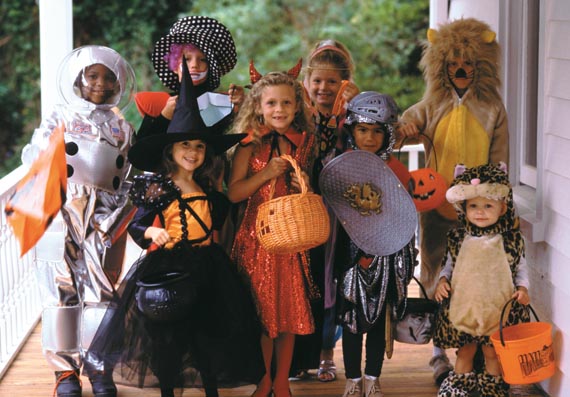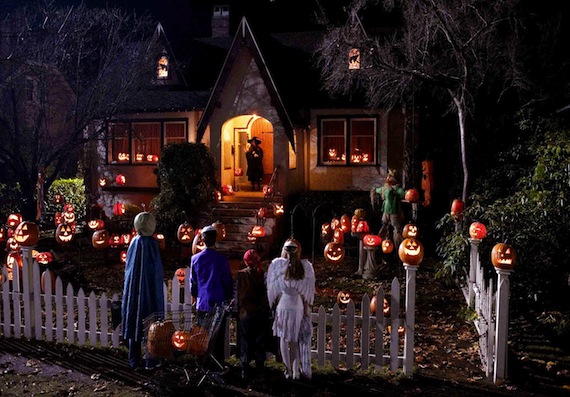HALLOWEEN

TRICK
In North America, trick or treat has been a customary Halloween tradition since at least the late 1950s. Homeowners wishing to participate in it usually decorate their private entrance with artificial spider webs, plastic skeletons and jack-o-lanterns. Some rather reluctant homeowners would simply leave the candy in bowls on the porch, others might be more participative and would even ask an effort from the children in order to provide them with candy. In the more recent years, however, the practice has spread to almost any house within a neighborhood being visited by children, including senior residences and condominiums.
The tradition of going from door to door receiving food already existed in Great Britain and Ireland in the form of "souling", where children and poor people would sing and say prayers for the dead in return for cakes. Guising—children disguised in costumes going from door to door for food and coins—also predates trick or treat, and is recorded in Scotland at Halloween in 1895, where masqueraders in disguise carrying lanterns made out of scooped out turnips, visit homes to be rewarded with cakes, fruit and money. While going from door to door in disguise has remained popular among Scots and Irish, the North American custom of saying "trick or treat" has recently become common. The activity is prevalent in the United States, Canada, United Kingdom, Republic of Ireland, Puerto Rico, and northwestern and central Mexico. In the latter, this practice is called calaverita (Spanish for "little skull"), and instead of "trick or treat", the children ask ¿me da mi calaverita? ("can you give me my little skull?"); where a calaverita is a small skull made of sugar or chocolate.
The practice of dressing up in costumes and begging door to door for treats on holidays dates back to the Middle Ages and includes Christmas wassailing. Trick-or-treating resembles the late medieval practice of souling, when poor folk would go door to door on Hallowmas (November 1), receiving food in return for prayers for the dead on All Souls Day (November 2). It originated in Ireland and Britain,[1] although similar practices for the souls of the dead were found as far south as Italy. Shakespeare mentions the practice in his comedy The Two Gentlemen of Verona (1593), when Speed accuses his master of "puling [whimpering or whining] like a beggar at Hallowmas." The custom of wearing costumes and masks at Halloween goes back to Celtic traditions of attempting to copy the evil spirits or placate them, in Scotland for instance where the dead were impersonated by young men with masked, veiled or blackened faces, dressed in white.
Guising at Halloween in Scotland is recorded in 1895, where masqueraders in disguise carrying lanterns made out of scooped out turnips, visit homes to be rewarded with cakes, fruit and money. The practice of Guising at Halloween in North America is first recorded in 1911, where a newspaper in Kingston, Ontario reported children going "guising" around the neighborhood.
TREAT
Some organizations around the US sponsor a "Trunk-or-Treat" on Halloween night (or on occasion, a day immediately preceding Halloween), where trick-or-treating is done from parked car to parked car in a local parking lot, often at a church house. The trunk of one's car is opened, displaying candy and often decorations. Concerned parents see it as safer for their children, while other parents see it as an easier alternative to walking the neighborhood with their kids.
Opponents frown upon the Trunk-or-Treat as violation of the tradition of walking door-to-door on Halloween, and as exclusion of children that do not belong to these groups and thus are not informed about them. Some have called for more city- or community group-sponsored Trunk-or-Treats, so they can be more inclusive. Many neighborhoods see a large reduction in door-to-door trick-or-treating because of a competing Trunk-or-Treat. These have become increasingly popular over the years especially in conservative states like Utah, and are catching on around Midwest and Southern states. Emanuel Lutheran in Inver Grove Heights MN welcomes over 600 children at their Trunk or Treat on the Friday before Halloween.
In some parts of Canada, children sometimes say "Halloween apples" instead of "trick or treat." This probably originated when the toffee apple was a popular type of candy. Apple-giving in much of Canada, however, has been taboo since the 1960s when stories (almost certainly apocryphal) appeared of razors hidden inside Halloween apples; parents began to check over their children's "loot" for safety before allowing them to eat it. In Quebec, children also go door to door on Halloween. However, in French speaking neighbourhoods, instead of "Trick or treat?", they will simply say "Halloween", though in tradition it used to be La charité s'il-vous-plaît ("Charity, please").
In some parts of Ohio, Iowa, Massachusetts and other states, the night designated for trick-or-treating is referred to as Beggars Night, and in some communities it is held on a night prior to Halloween itself.
In Sweden children dress up as witches and go trick-or-treating on Maundy Thursday (the Thursday before Easter) while Danish children dress up in various attires and go trick-or-treating on Fastelavn (or the next day, Shrove Monday). The Easter witch tradition is done on Palm Sunday in Finland. In parts of Flanders and some parts of the Netherlands and most areas of Germany, Switzerland and Austria, children go to houses with home made beet lanterns or with paper lanterns (which can hold a candle or electronic light), singing songs about St. Martin on St. Martin's Day (the 11th of November), in return for treats. In Northern Germany and Southern Denmark children dress up in costumes and go trick-or-treating on New Year's Eve in a tradition called "Rummelpott".
TRADITION
